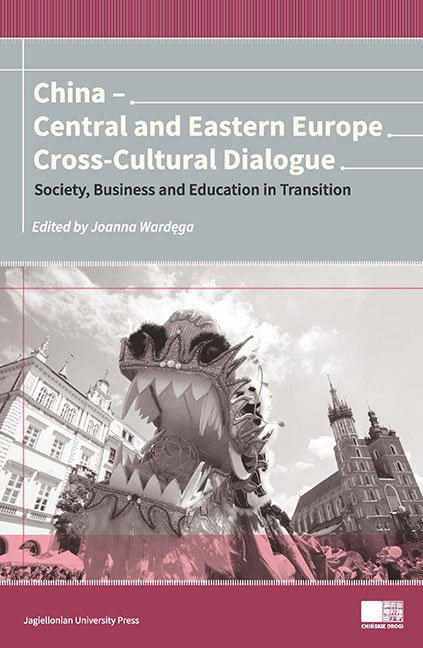Book contents
- Frontmatter
- Contents
- Foreword
- PART I Society and Culture in Transition
- PART TWO Economy and Markets in Transition
- PART THREE Education in Transition
- Opening the Two-Way Fast Lane for China-CEE Cultural Exchange by Equally Valuing the International Promotion of the Chinese Language and the CEE Languages Teaching
- A Contrastive Analysis of Traditional Chinese and Western Teaching Styles – A Case Study
- How Does Learning Style and Teaching Style Jointly Relate to Cultural Intelligence? A Study of Chinese Overseas Students
- Preparation of University Students from Western Cultures for Cooperation with China: Reasons and Methods
- Facing the Challenges of Teaching Chinese through Confucius Classrooms in Slovenian Schools: Current Situation and Prospects
- The Role of the Confucius Institute at Ss. Cyril and Methodius University in Skopje in Promoting the Chinese language, Culture and Business in the Republic of Macedonia
- Education in Transition of China-Based Jesuits from the Austrian Province
- Link in the History: The Development of the Research on Avguštin Hallerstein and its Contemporary Meaning
- Contributors
Facing the Challenges of Teaching Chinese through Confucius Classrooms in Slovenian Schools: Current Situation and Prospects
from PART THREE - Education in Transition
Published online by Cambridge University Press: 22 December 2017
- Frontmatter
- Contents
- Foreword
- PART I Society and Culture in Transition
- PART TWO Economy and Markets in Transition
- PART THREE Education in Transition
- Opening the Two-Way Fast Lane for China-CEE Cultural Exchange by Equally Valuing the International Promotion of the Chinese Language and the CEE Languages Teaching
- A Contrastive Analysis of Traditional Chinese and Western Teaching Styles – A Case Study
- How Does Learning Style and Teaching Style Jointly Relate to Cultural Intelligence? A Study of Chinese Overseas Students
- Preparation of University Students from Western Cultures for Cooperation with China: Reasons and Methods
- Facing the Challenges of Teaching Chinese through Confucius Classrooms in Slovenian Schools: Current Situation and Prospects
- The Role of the Confucius Institute at Ss. Cyril and Methodius University in Skopje in Promoting the Chinese language, Culture and Business in the Republic of Macedonia
- Education in Transition of China-Based Jesuits from the Austrian Province
- Link in the History: The Development of the Research on Avguštin Hallerstein and its Contemporary Meaning
- Contributors
Summary
With the growing demand for the Chinese language and culture in Slovenian schools and the establishment of Confucius Classrooms (CCs), Slovenian schools are facing many challenges. The present paper examines important issues in teaching Chinese through CCs in Slovenian kindergartens, primary schools and secondary schools.
The first Confucius Classroom in Slovenia was established in Maribor at the 2nd High School in Maribor in 2013. It was followed by Confucius Classroom Ljubljana at Trnovo Primary School in 2013, Confucius Classroom Kranj at the Krnaj High School in 2014 and Confucius Classroom Koper at the University of Primorska in 2014. The Slovenian Ministry of Education, Science and Sport has confirmed the curriculum for the Chinese language in Slovenian primary schools (2011) and high schools (2013). The “Chinese culture and language” pilot project was first introduced in two Slovenian primary schools: France Prešeren Primary School and Gorje Primary School. In the school year 2012/2013, the project started in the form of an enrichment of activities as extracurricular activities involving the Chinese culture and language in H. C. Andersen Kindergarten, Trnovo Primary School, Koseze Primary School and Tone Čufar Primary School in Ljubljana. In the school year 2013/2014, in cooperation with and under the sponsorship of the National Education Institute of the Republic of Slovenia, Trnovo Primary School, introduced the “Chinese culture and language” project to the Slovenian education system. Since 2012, presentations of Chinese culture and language are held on a regular basis every year in the form of creative workshops at Trnovo and Koseze primary schools.
During the three years of teaching and learning Chinese in Slovenian primary schools and secondary schools, a survey on teaching the Chinese language through CCs was conducted among Slovenian sinologists and Chinese teachers. The results of the survey yield some important data and insights on how to improve teaching Chinese in Slovenia. The key research questions addressed in this paper are:
What do we need for a successful introduction of the Chinese language and culture classes to the Slovenian education system?
How to create a sequenced, articulated curriculum?
How to promote Chinese language learning in Slovenia?
How to face the shortage of qualified teachers?
- Type
- Chapter
- Information
- China - Central and Eastern Europe Cross-Cultural Dialogue Society, Business and Education in Transition , pp. 375 - 390Publisher: Jagiellonian University PressPrint publication year: 2016

